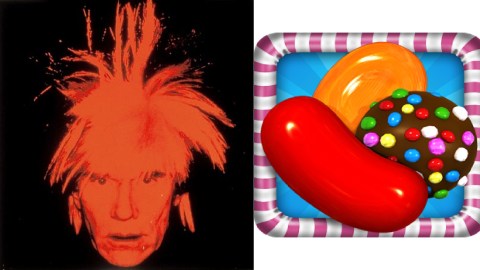Andy Crush: Warhol, Boredom, and Technology

Andy Warhol should have lived to see the age of smartphones. Before his death in 1987, Warhol witnessed the dawn of the personal computer and even played around making images on an Amiga. For someone like Warhol, fascinated by time’s fleetingness — most famously, his “15 minutes of fame” quip — today’s technology and its ability to save us from boredom anywhere, anytime would seem miraculous. Scholar Scott C. Richmond recently examined what Warhol’s art, especially in his “Stillies” films, says about the nature of boredom (profound, vulgar, and mediatic) and how we use casual games such as Candy Crush to escape or enjoy it.

Image: Two frames from Andy Warhol’s 1963 film Empire. Image source:Wikipedia. “Empire Andy Warhol” by Source. Licensed under Fair use via Wikipedia – https://en.wikipedia.org/wiki/File:Empire_Andy_Warhol.jpg#/media/File:Empire_Andy_Warhol.jpg
Richmond begins his article, “Vulgar Boredom, or What Andy Warhol Can Teach Us about Candy Crush” (in the April 2015 issue of The Journal of Visual Culture), with an anecdote about a recent showing of Warhol’s 1964 film Empire at the Museum of Modern Art in New York. Consisting of six hours of footage of the Empire State Building slowed down one third to make it feel even slower, Empire (stills from which appear above) is “perversely” (as Richmond puts it) designed to bore you to tears. Rather than fight the current, “MoMA invited its viewers to engage in a form of ‘bad behavior’ typical of our 21st-century media culture,” Richmond writes, “to pull out their phones in a movie theater so they could be just a little bit elsewhere, just for a little while.” Being bored (and responding to that boredom) became part of the aesthetic experience of watching the film. Inspired by that story, Richmond set out to see what else Warhol can say about the 21st century, boredom, and technology.

Image: Andy Warhol, 100 Cans (1962). Image source:Wikiart.
Richmond focuses not only on Empire, but also on other “Stillies” films by Warhol, including 1963’s Kiss (50 minutes of multiple couples in multiple combinations making out), 1963’s Sleep (five-plus hours of watching a man asleep guaranteed to put you to sleep), and 1964’s Blow Job (35 minutes of a man’s facial reactions to fellatio performed [or not] off-camera). In the midst of all that repetitive boredom, Richmond finds profundity. As you watch Empire, for example, you begin to notice little things, such as the pattern of office lights going on and off over time, that make the “unboring boring,” in a phrase Richmond borrows from another scholar. In Warhol’s films, boredom’s not a flaw; it’s a feature. Once you’ve passed the boredom threshold, you enter into an almost Zen-like state of profound boredom that enhances the experience itself.
The people in that MoMA theater never broke that boredom barrier, but for those who’ve bought into the idea of Warhol’s films as art, they’re the cinematic equivalent of Warhol’s Campbell’s Soup Cans (example shown above) — an endless repetition of an everyday image that forces you either to turn away or to lean into the experience even deeper. Warhol allegedly ate a can of soup every day for lunch, which is either the most boring meal plan ever or a kind of ritual that made him appreciate each can and each day better.

Image: Movie poster for Inception (2010). Image source:Wikipedia. “Inception ver3” by Source. Licensed under Fair use via Wikipedia – https://en.wikipedia.org/wiki/File:Inception_ver3.jpg#/media/File:Inception_ver3.jpg
In contrast to the “profound boredom” of Empire, Richmond argues for the “vulgar boredom” of a film such as 2010’s Inception. “Inception asks its viewers to keep track of no fewer than four narrative levels, and then delivers an ambiguous Gestalt with its final moment, a narrative duck–rabbit,” Richmond argues. Inception entices you with content to interpret, “But actually, there is no there there,” Richmond concludes. Inception teases, whereas Empire pleases with minimalist content rather than razzle-dazzle amounting to an ambiguous zero in the end. (Who knows if that top keeps spinning at the end? Who cares?) Whereas “profound boredom” can lead us to someplace new and potentially interesting, “vulgar boredom” leads us nowhere — spinning endlessly and pointlessly like that top.

Image:Candy Crush Saga game setup example. Image source:Wikipedia. “Candy Crush Saga game setup example” by Source (WP:NFCC#4). Licensed under Fair use via Wikipedia – https://en.wikipedia.org/wiki/File:Candy_Crush_Saga_game_setup_example.jpg#/media/File:Candy_Crush_Saga_game_setup_example.jpg
Finally, Richmond arrives at the idea of “mediatic boredom,” which combines the best of profound and vulgar boredom in some ways. He defines “mediatic boredom” as “a prop for achieving a non-productive mode of presentness to myself and to the world that is slackened, diffuse, lateral.” Casual games such as Candy Crush Saga (shown above) can generate this “mediatic boredom.” Like Empire, Candy Crush is minimalist in the sense that there’s no strategy. You keep crushing candy over and over, like Andy meditatively, profoundly, boringly drinking his daily soup. Like Inception, however, there’s all the colorful razzle-dazzle to delight the eye and the technology to engage the mind (even if it’s empty intellectual calories in the end). Unlike Inception, however, Candy Crush doesn’t entice you into immersion into the razzle-dazzle. By skimming that attractive surface as a way to escape the boredom around us, Candy Crush lets us be aware of ourselves (and our technology), at least for a moment.
“Social or not, games like Candy Crush solicit casual, attenuated, and extensive attunements with technical media,” Richmond concludes. “However attenuated these attunements may be, they are still attunements; they still set me in a relation to my technical media, now always on my person and increasingly on my body.” We’re literally surrounded by our own devices, with wearable technology such as Google Glass, iGlass, etc., shaving the body-technology barrier even thinner. Tuning them out is practically impossible. Using them to tune into ourselves (Richmond’s “attenuated attunements”), even for a moment, might be our only hope of stopping short of becoming soulless cyborgs. Richmond’s argument itself never bores and raises interesting questions not only about the art of Andy Warhol, but also about the art of being bored the best way.
[Top Image: (Left) Andy Warhol, Self-Portrait (1986). Image source:Wikiart. (Right) Candy Crush app icon. Image source:Wikipedia.]
[Please follow me on Twitter (@BobDPictureThis) and Facebook (Art Blog By Bob) for more art news and views.]





